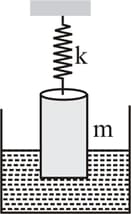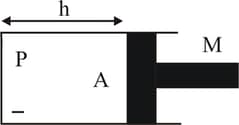A pendulum is executing simple harmonic motion and its maximum kinetic energy is If the length of the pendulum is doubled and it performs simple harmonic motion with the same amplitude as in the first case, its maximum kinetic energy is Then:

Important Questions on Simple Harmonic Motion
A wooden cube (density of wood ) of side floats in a liquid of density with its upper and lower surfaces horizontal. If the cube is pushed slightly down and released, it performs a simple harmonic motion of period . Then, is equal to:
A cylindrical plastic bottle of negligible mass is filled with of water and left floating in a pond with still water. If pressed downward slightly and released, it starts performing simple harmonic motion at angular frequency, . If the radius of the bottle is then is close to (density of water )
A highly rigid cubical block of small mass and side is fixed rigidly on to another cubical block of the same dimensions and of low modulus of rigidity such that the lower face of completely covers the upper face of . The lower face of is rigidly held on a horizontal surface. A small force is applied perpendicular to one of the side faces of . After the force is withdrawn, block executes small oscillations, the time-period of which is given by
A uniform cylinder of mass and length having an area of cross-section is suspended lengthwise with the help of a massless spring of constant . The cylinder is half-submerged in a liquid of density . A small push and release make it vibrate with a small amplitude. The frequency of oscillation is:

A cylindrical piston of mass slides smoothly inside a long cylinder closed at one end, enclosing a certain mass of a gas. The cylinder is kept with its axis horizontal. If the piston is disturbed from its equilibrium position, it oscillates simple harmonically. The period of oscillation will be (process is isothermal)

A U-tube contains mercury of total length as shown and is disturbed so that it oscillates back and forth from arm to arm. If we neglect friction, the period of oscillation is:

